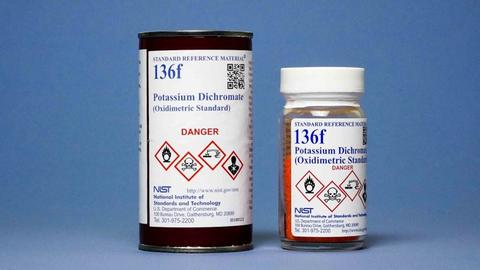Evaluation of Independent High-Precision Assay Procedures for a High-Purity Primary Standard Reagent
Summary
NIST assigns assay values for a suite of high-purity reagents using two techniques: coulometry and titrimetry. Coulometry is based on Faraday's Laws of Electrolysis (amount of substance is proportional to electrical charge). Titrimetry relies on the equality of amount of a standard substance and the titrated sample. Each method can readily achieve a reproducibility of better than 0.01% in the assay value of specified primary standard reagents. The present work was targeted toward an assessment of the uncertainty of independent titrimetric and coulometric assays of a single primary standard material, Potassium Dichromate, in the course of its certification as Standard Reference Material (SRM) 136f. The resulting certified value and uncertainty are based on a combination of both methods.
Description

SRM 136f Potassium Dichromate
The NIST high-purity primary standard reagent SRMs are the benchmark for a wide variety of acidimetric and oxidation-reduction titrations. This suite of SRMs includes SRM 84k Potassium Hydrogen Phthalate, SRM 350b Benzoic Acid, and SRM 973 Boric Acid, each used as a standard acid. SRM 723d Tris(hydroxymethylamino)methane and SRM 351a Sodium Carbonate are used as standard bases. SRM 999b Potassium Chloride is used in argentimetric titrations and as a K and Cl standard. SRM 136f Potassium Dichromate is a widely used oxidimetric standard reagent. Probably the most critical use for SRM 136f is in the assay of uranium in nuclear safeguards analyses. Here, a low uncertainty is necessary in exposing diversion, loss, or theft of fissionable material.
Major Accomplishments
- Coulometric assays and homogeneity assessment of SRM 136f.
- New titrimetric assay for potassium dichromate vs. arsenious oxide. Second, independent assay of SRM 136f.
- Certified assay and uncertainty for SRM 136f using a GUM-compliant approach.
Additional Technical Details
A problem that arose in the certification of SRM 189c was that the reagent (potassium tetroxalate dihydrate) was not available with the requisite stoichiometry and homogeneity. To obtain suitable material, NIST staff consulted the original literature and advised candidate suppliers on the custom preparation of a large SRM batch. A trial intermediate-size batch was stoichiometric, but it contained excess water. However, as an uncharacterized material, it was ideally suited for the CCQM-K20 Key Comparison, which NIST coordinated in the same time period. The final SRM batch met all specifications and was used for the SRM 189c renewal.
Based on earlier results (CCQM-K19 Carbonate Buffer), in the certification of SRM 191d Carbonate Buffer, the design of the Harned cells was modified to improve equilibration with the equilibrium CO2 pressure over the buffer solution. This modification significantly improved the primary measurement and permitted the certification to be performed at additional temperatures.
Associated Products
RM 8040a Sodium Oxalate
SRM 136f Potassium Dichromate
SRM 350c Benzoic Acid (Acidimetric Standard)
SRM 351a Sodium Carbonate
Tris(hydroxymethyl)aminomethane (HOCH2)3CNH2 (Acidimetric Standard)
SRM 973 Boric Acid
SRM 999c Potassium Chloride Primary Standard
SRM 2185 Potassium Hydrogen Phthalate
ASSOCIATED PUBLICATIONS
- K. W. Pratt, Automated, High-Precision Coulometric Titrimetry 1. Engineering and Implementation, Anal. Chim. Acta, 1994, 289, 125-134.
- K. W. Pratt, Automated, High-Precision Coulometric Titrimetry 2. Strong and Weak Acids and Bases, Anal. Chim. Acta, 1994, 289, 135-142.

